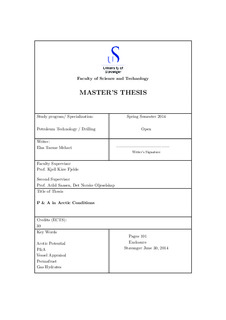| dc.description.abstract | All oil and gas wells will require plugging and abandonment (p&a) at some point in their operating life. Considering the challenging nature of the Arctic weather, its remoteness and lack of infrastructures, and its ice conditions, conducting this operation in the High Arctic will have the potential to be more costly, time consuming, and challenging. In addition, Arctic weather and ice conditions are difficult to predict. For instance, drift ice cover varies from open waters in the summer to very close drift ice in the winter, but the drift pattern is difficult to predict because of influences from tidal currents and winds (Keinonen, A., et al., 2000). Therefore, it is very important to understand the High Arctic environment so as to get familiar with challenges that can be encountered during p&a operations in the environment. This will make it possible to develop means of conducting safe, and time and cost effective Arctic p&a operations.
The thesis presents the challenges and possible solutions for p&a operation in Arctic environments in terms of safety and cost effectiveness. In order to comply with the already established standards, norsok-d-10 rev-4 and ukooa are reviewed.
• The study shows that the main challenges of Arctic subsea p&a are associated with the extreme weather condition of the Arctic, Arctic ice conditions such as sea ice and icebergs, and remoteness and lack of infrastructures in the Arctic. Others are spill management problems, p&a vessel challenges, permafrost, and cementing related challenges.
• Solutions suggested to these challenges from this study include the need to develop ship-shaped vessels that are enabled for high Arctic operations such as Category A vessels (or the Category I Arctic drilling vessel) with full capabilities for the three phases of well abandonment specified in the Oil and Gas UK standard for p&a operations (Oil and Gas, UK; 2011). Another possibility is to combine the Category A and Category I vessels such that jobs like logging and bullheading can be done by the Category A vessels, while heavier jobs such as cutting and pulling of tubing can be done by the Category I vessels. The study also suggests that before deciding on combining vessels for Arctic p&a operations, one must consider that increased cost of vessel mobilization would result and that it is likely that there will be limited number of Arctic-enabled vessels in existence.
• Other suggested solutions include the need for ice management to support the operations of the p&a vessels in the Arctic, use of batch campaigns to reduce vessel mobilization cost and to solve logistic challenges due to remoteness of Arctic offshore oil and gas fields, and use of PPEs customized to the weather condition on each field location. Furthermore, the need for zero tolerance for spills in the Arctic, and the need for freeze protected cement slurry to prevent freezing of cement are also suggested.
• To reduce the time needed for Arctic p&a operations due to the short open water season, it is suggested to design Arctic wells such that milling and pulling of production tubing can be avoided during the p&a operations. This would help to increase the effectiveness of batch operations in the region, make it possible to use simpler p&a vessels, and reduce operations cost. Avoiding milling would also help to reduce chances of mud loss, thereby enabling environmentally friendly Arctic p&a operations. | nb_NO |
